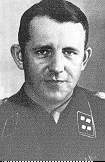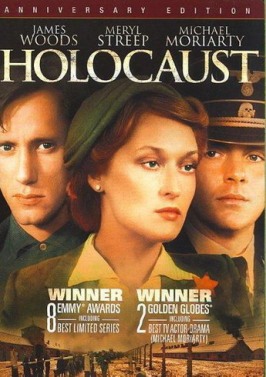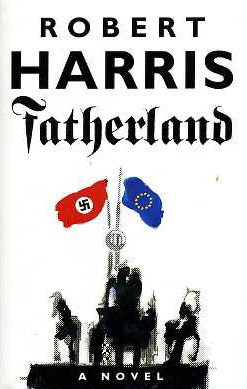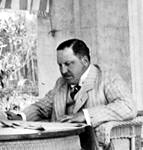
The Final Solution or the Final Solution to the Jewish Question was a Nazi plan for the genocide of individuals they defined as Jews during World War II. The "Final Solution to the Jewish question" was the official code name for the murder of all Jews within reach, which was not restricted to the European continent. This policy of deliberate and systematic genocide starting across German-occupied Europe was formulated in procedural and geopolitical terms by Nazi leadership in January 1942 at the Wannsee Conference held near Berlin, and culminated in the Holocaust, which saw the murder of 90% of Polish Jews, and two-thirds of the Jewish population of Europe.

Reinhard Tristan Eugen Heydrich was a high-ranking German SS and police official during the Nazi era and a principal architect of the Holocaust.

The Wannsee Conference was a meeting of senior government officials of Nazi Germany and Schutzstaffel (SS) leaders, held in the Berlin suburb of Wannsee on 20 January 1942. The purpose of the conference, called by the director of the Reich Security Main Office SS-Obergruppenführer Reinhard Heydrich, was to ensure the co-operation of administrative leaders of various government departments in the implementation of the Final Solution to the Jewish Question, whereby most of the Jews of German-occupied Europe would be deported to occupied Poland and murdered. Conference participants included representatives from several government ministries, including state secretaries from the Foreign Office, the justice, interior, and state ministries, and representatives from the SS. In the course of the meeting, Heydrich outlined how European Jews would be rounded up and sent to extermination camps in the General Government, where they would be killed.

Rudolf Lange was a German SS functionary and police official during the Nazi era. With the invasion of the Soviet Union, he served in Einsatzgruppe A before becoming a commander in the Sicherheitsdienst (SD) and all RSHA personnel in Riga, Latvia. He participated in the January 1942 Wannsee Conference, at which the genocidal Final Solution to the Jewish Question was planned, and was largely responsible for implementing the murder of Latvia's Jewish population during the Holocaust.

Reinhard Heydrich, the commander of the German Reich Security Main Office (RSHA), the acting governor of the Protectorate of Bohemia and Moravia and a principal architect of the Holocaust, was assassinated during the Second World War in a coordinated operation by the Czechoslovak resistance. The assassination attempt, code-named Operation Anthropoid, was carried out by resistance operatives Jozef Gabčík and Jan Kubiš on 27 May 1942. Heydrich was wounded in the attack and died of his wounds on 4 June.

Wannsee is a locality in the southwestern Berlin borough of Steglitz-Zehlendorf, Germany. It is the westernmost locality of Berlin. In the quarter there are two lakes, the larger Großer Wannsee and the Kleiner Wannsee, located on the River Havel and separated only by the Wannsee Bridge. The larger of the two lakes covers an area of 2.7 km2 (1.0 sq mi) and has a maximum depth of 9 m (30 ft).

Conspiracy is a 2001 made-for-television drama film that dramatises the 1942 Wannsee Conference. Using the authentic script taken from the only surviving transcript recorded during the meeting, the film delves into the psychology of Nazi officials involved in the "Final Solution of the Jewish question" during World War II.

Martin Franz Julius Luther was a German diplomat. An early member of the Nazi Party, he served as an advisor to Foreign Minister Joachim von Ribbentrop, first in the Dienststelle Ribbentrop, and later in the Auswärtiges Amt as a diplomat when von Ribbentrop replaced Konstantin von Neurath. He participated in the January 1942 Wannsee Conference, at which the genocidal Final Solution to the Jewish Question was planned; it was the 1947 discovery of his copy of the minutes that first made the Allied powers aware that the conference had taken place and what its purpose was.

Holocaust (1978) is an American television miniseries which aired on NBC over four nights, from April 16 — April 19, 1978.

Fatherland is a 1992 alternative history detective novel by English writer and journalist Robert Harris. Set in a universe in which Nazi Germany won World War II, the story's protagonist is an officer of the Kripo, the criminal police, who is investigating the murder of a Nazi government official who participated at the Wannsee Conference. A plot is thus discovered to eliminate all of those who attended the conference, to help improve German relations with the United States.
The Wannsee Conference is a 1984 German TV film portraying the events of the Wannsee Conference, held in Berlin in January 1942. The script is derived from the minutes of the meeting. Since no verbatim transcription of the meeting exists, the dialogue is necessarily fictionalised. The main theme of the film is the bureaucratic nature of the genocide.
The Reich Chancellery meeting of 12 December 1941 was an encounter between Adolf Hitler and the highest-ranking officials of the Nazi Party. Almost all important party leaders were present to hear Hitler declare the ongoing destruction of the Jewish race, which culminated in the Holocaust. The meeting is less known than the later Wannsee Conference.

Joseph Wulf was a German-Polish Jewish historian. A survivor of the Auschwitz concentration camp, he was the author of several books about Nazi Germany and the Holocaust, including Das Dritte Reich und die Juden ; Heinrich Himmler (1960); and Martin Bormann: Hitlers Schatten (1962). The House of the Wannsee Conference museum in Berlin houses the Joseph Wulf Library in his honour.

Friedrich Minoux was a German industrialist and financier who is best known for being one of the owners of the Wannsee House, where the namesake conference that would decide the fate of millions at the hands of the Nazis during World War II was held in early 1942.

Lina Mathilde Manninen was the wife of Reinhard Heydrich, head of the Reich Security Main Office and a central figure in Nazi Germany. The daughter of a minor German aristocrat, she joined the Nazi Party in 1929 and met Reinhard Heydrich in December 1930. The two wed on 26 December 1931 and had four children. After World War II ended, she published a memoir in 1976. She spoke with several authors, wrote letters of correction to many newspapers, and defended the reputation of her first husband (Heydrich) until her death at age 74 in August 1985 in Fehmarn.

Heinz Siegfried Heydrich was the son of Richard Bruno Heydrich and the younger brother of SS-Obergruppenführer Reinhard Heydrich. After the death of his brother in June 1942, Heinz Heydrich helped Jews escape the Holocaust.

Ernst Ferdinand Emil Marlier was a German pharmaceutical manufacturer who built the Wannsee Villa, where the Wannsee Conference was held.
The Stiftung Nordhav was a front organization of the Sicherheitsdienst (SD) founded in 1939 by Reinhard Heydrich to obtain and manage real estate for the SS.
Dramatic portrayals of Reinhard Heydrich number among the more numerous of any Second World War figure, comparable to Adolf Hitler as well as war films depicting Erwin Rommel. Reinhard Heydrich has been portrayed in both television and film, and was one of the few high ranking Nazis to be depicted in a dramatic film while the Second World War was still ongoing.
Die Wannseekonferenz, international title The Conference, is a German TV docudrama, first aired January 24, 2022 by the ZDF broadcaster, about the Wannsee Conference held in Berlin-Wannsee in 1942 to organise the extermination of the Jews.















